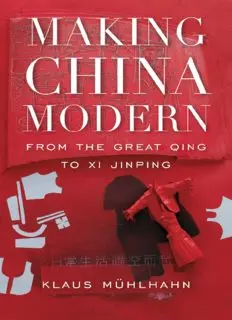
Making China Modern: From the Great Qing to Xi Jinping PDF
Preview Making China Modern: From the Great Qing to Xi Jinping
Making China Modern Making China Modern From the G reat Qing to Xi Jinping Klaus Mühlhahn The Belknap Press of Harvard University Press cambridge, mas sa chu setts london, england · 2019 Copyright © 2019 by the President and Fellows of Harvard College All rights reserved Printed in the United States of Amer i ca First printing Jacket artwork by Qiu Zhijie Jacket design by Jill Breitbarth 9780674916074 (EPUB) 9780674916081 (MOBI) 9780674916067 (PDF) Book design by Dean Bornstein The Library of Congress has cataloged the printed edition as follows: Names: Mühlhahn, Klaus, author. Title: Making China modern : from the Great Qing to Xi Jinping / Klaus Mühlhahn. Description: Cambridge, Mas sa chu setts : The Belknap Press of Harvard University Press, 2019. | Includes bibliographical references and index. Identifiers: LCCN 2018008769 | ISBN 9780674737358 (alk. paper) Subjects: LCSH: China— History— Qing dynasty, 1644–1912. | China— History— Republic, 1912–1949. | China— History—1949– Classification: LCC DS754 .M84 2018 | DDC 951— dc23 LC rec ord available at https:// lccn . loc . gov / 2018008769 For Sophia, Clara, and Julius Our nation is new, but at the same time very ancient; it is modern and prosperous, but at the same time feudal and autocratic; it is west- ernized, but also intrinsically Asian. The world is transforming the nation, even as the nation is si mul ta neously transforming the world, and through this pro cess the nation’s innovation lies in its use of an un- fathomable reali ty to challenge the limits of human imagination. As a result, the nation has come to acquire a sort of unrealistic reali ty, a non- existent existence, an impossible possibility—in short, it has come to possess an invisible and intangible set of rules and regulations. — Yan Lianke, The Explosion Chronicles Contents Timeline: China, 1644–2017 ix List of Maps xiii Introduction 1 Part 1 The Rise and Fall of Qing China 21 1 Age of Glory: 1644–1800 25 2 Reordering the Chinese World: 1800–1870 85 3 Late Qing Predicaments: 1870–1900 153 Part 2 Chinese Revolutions 203 4 Upending the Empire: 1900–1919 209 5 Rebuilding during the Republican Era: 1920–1937 248 6 China at War: 1937–1948 298 Part 3 Remaking China 353 7 Socialist Transformation: 1949–1955 359 8 Leaping Ahead: 1955–1960 408 9 Overthrowing Every thing: 1961–1976 448 Part 4 China Rising 487 10 Reform and Opening: 1977–1989 491 11 Overall Advance: 1990–2012 527 12 Ambitions and Anx i eties: Con temporary China 560 Abbreviations 617 Notes 619 Acknowl edgments 695 Index 701 Timeline: China, 1644–2017 1644–1911 Qing dynasty 1683 Qing troops defeat Ming- loyalist Zheng Chenggong (Konxinga) in Taiwan 1689 Treaty of Nerchinsk between Qing China and Tsarist Rus sia 1712 Mission of Manchu official to Rus sia 1715 East India Com pany opens trading station in Guangzhou c. 1700–1800 “High Qing,” an age of prosperity and growth 1755–59 Conquest of central Asian lands (Xinjiang) 1757–1842 Foreign trade limited to the port of Guangzhou (“Canton system”) 1780s Literary inquisitions by the Qianlong emperor 1793 British Macartney mission to China fails to accelerate trade 1796–1804 White Lotus Rebellion 1799 Ban on import and cultivation of opium 1820–50 Economic depression under the Daoguang emperor 1840–42 First Opium War; Treaty of Nanjing opens Chinese ports to foreign trade; Hong Kong ceded to Great Britain; reparation payments; end of “Canton system” 1851–64 Taiping Rebellion 1856–60 Second Opium War; more ports opened; further rights granted to foreigners 1861 Founding of the Zongli Yamen, China’s foreign office 1865–66 Opening of the first arsenals, producing battleships and armor 1873 Founding of China Merchant Steamship Com pany 1879 Japan seizes Ryukyu Islands, former tributary of the Qing 1883–85 Sino- French War 1890s Beiyang Army formed by Li Hongzhang 1894 Hanyang Ironworks begin production 1894–95 Sino- Japanese War; Taiwan becomes Japa nese colony 1895 “Self- Strengthening Army” created by Zhang Zhidong 1895–1911 Railway construction booms 1897 Qingdao occupied by Germany; Imperial Bank of China founded in Shanghai 1898 Hundred Days Reform, violently ended by empress dowager Cixi; Zhang Zhidong coins slogan “Chinese learning as substance, Western learning as function” ( ix )
